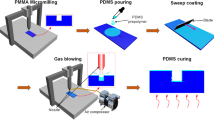Abstract
Micro-fluidic channel was fabricated on a PMMA sheet (thickness of 1.5 mm) using 248 nm excimer laser direct-writing technique. The influence of excimer laser fluence on the micromachining quality (channel’s depth and surface roughness) was analyzed. Higher laser fluence results in the augmentation of channel’s depth and surface roughness. The excimer laser polishing processing is favorable for the improvement of surface roughness. However, over-abundant polishing will generate tenuous stripe on the channel’s edge and worsen the surface roughness.





Similar content being viewed by others
References
Ando M, Negishi M, Takimoto M et al (1995) Super-smooth polishing on aspherical surfaces. Nanotechnology 6:111–120
Cheng JY, Wei CW, Hsu KH et al (2004) Direct-write laser micromachining and universal surface modification of PMMA for device development. Sens Actuat B 99:186–196
Christensen CP (1993) Capabilities of low power excimer lasers in micromachining. In: IEEE Lasers Electro Opt Soc Annu Meet, pp 762–763
Croce G, D’Agaro P (2005) Numerical simulation of roughness effect on micro-channel heat transfer and pressure drop in laminar flow. J Phys D (Appl Phys) 38:1518–1530
Etoh S, Fujimura T, Hattori R et al (2003) Fabrication of on-chip microcapillary using photosensitive glass. Microsyst Technol 9:541–545
Feng Y, Liu ZQ, Yi XS (2000) Co-occurrence of photochemical and thermal effects during laser polymer ablation via a 248-nm excimer laser. Appl Surf Sci 156:177–182
Hu YD, Werner C, Li DQ (2003) Influence of three-dimensional roughness on pressure-driven flow through micro-channels. J Fluids Eng 125:871–879
Lee GB, Chen SH, Huang GR et al (2001) Microfabricated plastic chips by hot embossing methods and their applications for DNA separation and detection. Sens Actuat B 75:142–148
Manz A, Graber N, Widmer HM (1990) Miniaturized total chemical analysis systems: A novel concept for chemical sensing. Sens Actuat B Chem B1:244–248
Reyes DR, Iossifidis D, Auroux PA et al (2002) Micro total analysis systems. Anal Chem 74:2623–2652
Robinson K (2005) Photolithography technique improves capillary electrophoresis chip design. Biophoton Int 12:17–19
Tokarev VN, Marine W, Pra C et al (1995) “Clean” processing of polymers and smoothing of ceramics by pulsed laser melting. J Appl Phys 77:4714–4723
Vilkner T, Janazek D, Manz A (2004) Micro total analysis systems. Recent developments. Anal Chem 76:3373–3386
Wang XQ, Yap C, Mujumdar AS (2005) Effects of two-dimensional roughness in flow in micro-channels. J Electron Packaging 127:357–361
Zhang B, Liu H, Karqer BL et al (1999) Microfabricated devices for capillary electrophoresis-electrospray mass spectrometry. Anal Chem 71:3258–3264
Author information
Authors and Affiliations
Corresponding author
Rights and permissions
About this article
Cite this article
Heng, Q., Tao, C. & Tie-chuan, Z. Surface roughness analysis and improvement of micro-fluidic channel with excimer laser. Microfluid Nanofluid 2, 357–360 (2006). https://doi.org/10.1007/s10404-006-0078-7
Received:
Accepted:
Published:
Issue Date:
DOI: https://doi.org/10.1007/s10404-006-0078-7




